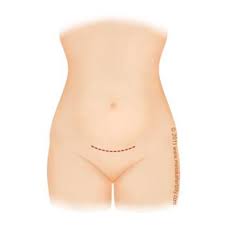Caesarean section in breech position
A cesarean section is a major operation in the abdomen. Usually during the operation, the lower part of your body is anaesthetized. So you’re awake during the surgery. In the operating room the obstetrician makes an incision in your abdomen, just above the pubic bone. Via this incision your baby is born.

Outline of a planned caesarian section
A scheduled caesarean section will take place just one week before you’re due. This is between the 39th and 40th week of pregnancy. This always happens on a working day, not on weekends. Sometimes the delivery starts spontaneously before the scheduled date. In this event, if desired, you will then be asked again how you want to give birth. If your choice remains a caesarean section, the caesarean section will be done at that time. This is called an unplanned caesarean section and is sometimes called an emergency caesarean section. This does not mean that there is urgency for the baby to be born, merely that the caesarean section is not scheduled, but it can be performed at any time. If by chance the baby has turned to a head-down position just before the caesarean section, the caesarean section will be cancelled.
In the OLVG we try to perform – where possible – a gentle or natural caesarean section. This means as soon as possible after birth your baby will be placed on your stomach and stay on your stomach for skin-to-skin contact and – if desired – breastfeeding. In case of an unplanned caesarean section, this is not always immediately possible. In half of the cases, of an unscheduled caesarean section it is possible to keep the baby with the mother. In any sort of caesarian birth (if you are awake) you can always watch your baby being born.
After the caesarean section, you and your partner will remain in the hospital for 24 to 48 hours. In the maternity ward you will be helped by the nurse to get back on your feet as quickly as possible and to be able to take care of your baby. For the first few weeks, you should not be doing any heavy lifting or household chores. Exercise can be painful and it takes an average of six weeks until you can do everything normally again.
The disadvantages of giving birth by caesarean section
- After surgery, you will have pain, which can make physical contact with your baby more difficult.
- Breastfeeding is also sometimes more difficult because you are less mobile and in pain.
- This can delay the start of breastfeeding.
- For the first 12 to 24 hours you will be bedbound and have an IV. You will however get sufficient pain relief.
- As you can’t walk to the toilet yourself, you will have a tube (catheter) in your bladder for the first 12 to 24 hours. This gives you a slightly higher risk of cystitis or symptoms of a urine infection.
- You are not allowed to lift for six weeks or perform household chores.
- Following one c-section you have more risk of additional problems in subsequent pregnancies.
Risks of surgery
For yourself:
- Hemorrhage, wound infection or the formation of blood clots that can cause complications (thrombosis).
- During the caesarean section there is a small risk of accidental incision into your bladder and/or bowel.
- With a wound infection, healing of the wound can take longer.
- In case of an unplanned caesarean section, the first contact with your baby can be delayed, because you cannot be directly together in the operating room.
- A bladder catheter can cause cystitis or you may have problems urinating after the catheter is removed.
For your baby:
- No (or delayed) direct skin-to-skin contact.
- Sometimes the baby may require admission to the special care baby unit.
- In the event of a caesarean section, there is a small increase in the risk that a baby could die.
Risks to subsequent pregnancies following an earlier caesarean
After a caesarean section, you will have a scar on your uterus. In the event of a subsequent birth the moment you go into labour, there’s a chance this scar could rupture (tear). This is called a uterine rupture. If this happens, the baby can only be born by an emergency caesarean section. Uterine rupture can cause the baby to be deprived of oxygen, thereby suffering brain damage or even death.
That’s why once you’ve had one caesarean section we advise you to give birth in the hospital for subsequent pregnancies.
After a caesarean section, problems can also occur with the growth of the placenta (placenta) in the case of a subsequent pregnancy. During discussion with the obstetrician you will be given more information about this.
More information about complications can be read with, additional information.
Warning: actual images